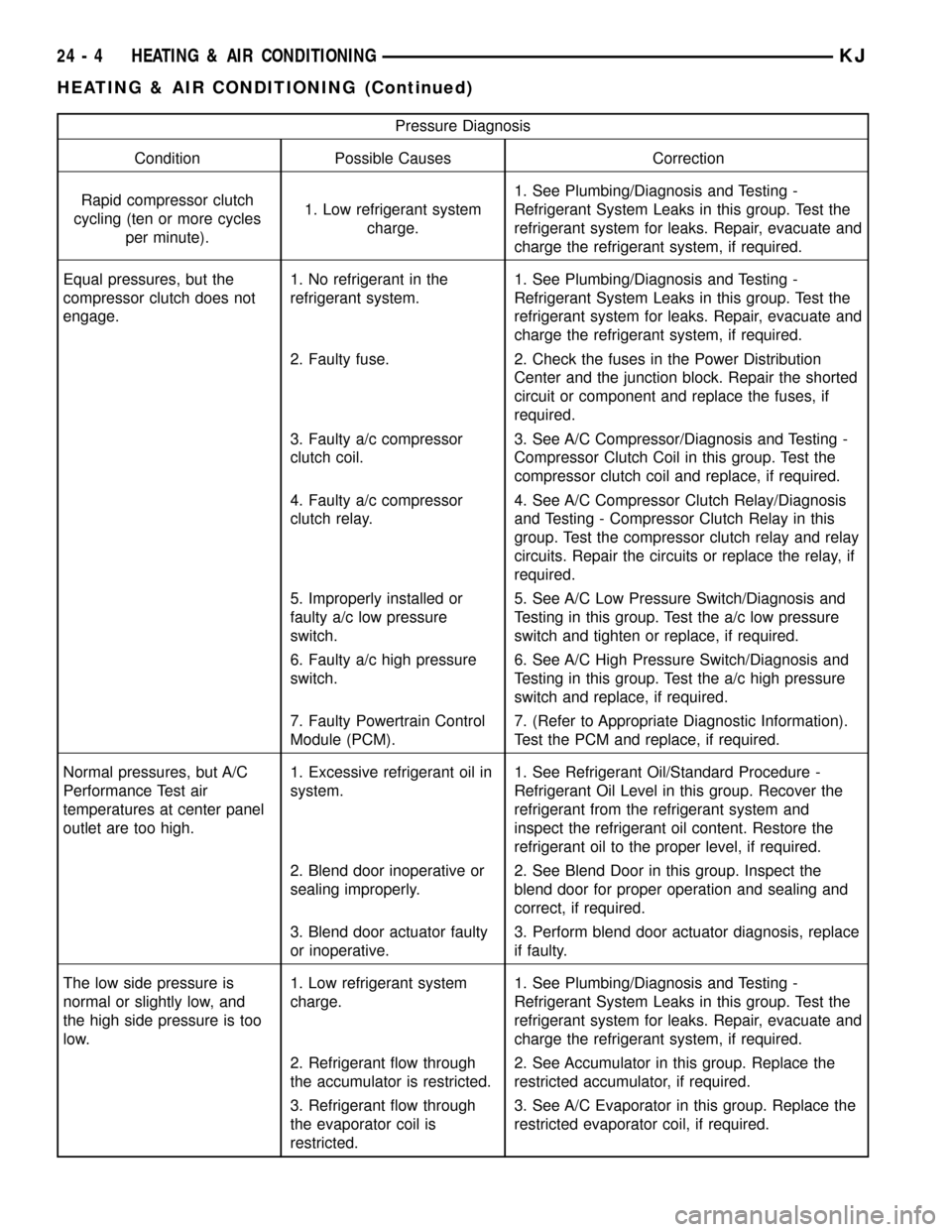2002 JEEP LIBERTY actuator
[x] Cancel search: actuatorPage 1595 of 1803

(3) Twist the glass division bar towards the inside
of the door and position the door glass into the rear
run channel.
(4) Lift glass up in the window and engage the pin
into the regulator lift plate.
(5) Raise the glass into the closed position and
install the division bar bolt.
(6) Tighten the bolt to 9 N´m (80 in. lbs.).
(7) Install the waterdam. (Refer to 23 - BODY/
DOORS - REAR/WATERDAM - INSTALLATION)
EXTERIOR HANDLE
REMOVAL
(1) Remove the waterdam. (Refer to 23 - BODY/
DOORS - REAR/WATERDAM - REMOVAL)
(2) Disconnect the actuator rod.
(3) Remove the nuts and remove the handle. (Fig.
5)
INSTALLATION
(1) Install the handle.
(2) Install the nuts and tighten to 6 N´m (55 in.
lbs.).
(3) Connect the actuator rod.
(4) Install the waterdam. (Refer to 23 - BODY/
DOORS - REAR/WATERDAM - INSTALLATION)
GLASS RUN CHANNEL
REMOVAL
(1) Remove the door glass. (Refer to 23 - BODY/
DOORS - REAR/DOOR GLASS - REMOVAL)
(2) Remove the outer belt molding. (Refer to 23 -
BODY/WEATHERSTRIP/SEALS/REAR DOOR
OUTER BELT MOLDING - REMOVAL)
(3) Remove the front and rear bolts. (Fig. 6)
(4) Peal the weatherstrip and quarter glass out of
the door frame and remove the run channel through
the window opening as an assembly.
INSTALLATION
(1) Install the run channel and quarter glass
assembly through the window opening and into the
door frame.
(2) Install the front, rear bolts and tighten to 9
N´m (80 in. lbs.).
(3) Install the outer belt molding. (Refer to 23 -
BODY/WEATHERSTRIP/SEALS/REAR DOOR
OUTER BELT MOLDING - INSTALLATION)
(4) Install the door glass. (Refer to 23 - BODY/
DOORS - REAR/DOOR GLASS - INSTALLATION)
Fig. 4 GLASS DIVISION BAR
1 - STATIONARY DOOR GLASS
2 - DIVISION BAR BOLT (1)
3 - DOOR
4 - GLASS DIVISION BAR
Fig. 5 EXTERIOR HANDLE
1 - NUTS (2)
2 - EXTERIOR HANDLE
23 - 130 DOORS - REARKJ
DOOR GLASS (Continued)
Page 1596 of 1803

HINGE
REMOVAL
(1) Remove the door. (Refer to 23 - BODY/DOORS
- REAR/DOOR - REMOVAL)
(2) Remove the upper b-pillar trim. (Refer to 23 -
BODY/INTERIOR/B-PILLAR UPPER TRIM -
REMOVAL)
(3) Remove the two door hinge bolts from the
inside of the b-pillar.
(4) Remove the exterior bolts attaching the door
hinges to the b-pillar.
INSTALLATION
(1) Install the hinges.
(2) Install the exterior bolts and tighten to 28 N´m
(21 ft. lbs.).
(3) Install the two inner hinge bolts and tighten to
28 N´m (21 ft. lbs.).
(4) Adjust the door as necessary. (Refer to 23 -
BODY/BODY STRUCTURE/GAP AND FLUSH -
SPECIFICATIONS)
(5) Install the upper b-pillar trim. (Refer to 23 -
BODY/INTERIOR/B-PILLAR UPPER TRIM -
INSTALLATION)
(6) Install the door. (Refer to 23 - BODY/DOORS -
REAR/DOOR - INSTALLATION)
LATCH
REMOVAL
(1) Remove the door glass. (Refer to 23 - BODY/
DOORS - REAR/DOOR GLASS - REMOVAL)(2) Disconnect the actuator rods.
(3) Remove the screws and remove the latch
assembly. (Fig. 7)
(4) Disconnect the electrical connectors.
INSTALLATION
(1) Connect the latch electrical connectors.
(2) Install the latch assembly into the door and
install the screws.
(3) Tighten the latch screws to 11 N´m (95 in. lbs.).
(4) Connect the actuator rods.
(5) Install the door glass. (Refer to 23 - BODY/
DOORS - REAR/DOOR GLASS - INSTALLATION)
(6) Adjust the latch as needed. (Refer to 23 -
BODY/DOORS - REAR/LATCH - ADJUSTMENTS)
ADJUSTMENTS
ADJUSTMENT
(1) Locate access hole and remove the mylar tape
covering it. (Fig. 8)
(2) Insert a 5/32-inch hex-wrench through hole and
into adjustment screw. Loosen screw.
(3) Operate outside handle several times to release
any restriction because of mis-alignment.
(4) Tighten adjustment screw to 3 N´m (30 in.
lbs.).
(5) Test handle and lock cylinder for proper opera-
tion.
Fig. 6 GLASS RUN CHANNEL
1 - BOLTS (3)
2 - QUARTER GLASS
3 - GLASS RUN CHANNEL ASSEMBLY
Fig. 7 LATCH
1-LATCH
2 - SCREWS (4)
KJDOORS - REAR 23 - 131
GLASS RUN CHANNEL (Continued)
Page 1597 of 1803

LATCH STRIKER
REMOVAL
(1) Remove the bolts. (Fig. 9)
(2) Remove the latch striker and the spacer, if
equipped.
INSTALLATION
(1) Install the striker and spacer.
(2) Install the bolts and tighten to 28 N´m (21 ft.
lbs.).
(3) Adjust the door as necessary. (Refer to 23 -
BODY/BODY STRUCTURE/GAP AND FLUSH -
SPECIFICATIONS)
TRIM PANEL
REMOVAL
(1) Remove the inside handle screw plug and
remove the screw. (Fig. 10)
(2) Remove the pull handle screw.
(3) Using a trim stick C-4755 or equivalent, disen-
gage the trim panel clips and remove the trim panel.
(4) Disconnect the electrical connectors and the
inside handle actuator rod. (Fig. 11)
INSTALLATION
(1) Connect the inside handle actuator rod and the
electrical connectors.
(2) Position the trim panel and seat the clips fully.
(3) Instal the screws and install the screw plug.
Fig. 8 LATCH ADJUSTMENT SCREW
1 - DOOR LATCH
2 - MYLAR TAPE
3 - ADJUSTMENT SCREW
Fig. 9 LATCH STRIKER
1 - C-PILLAR
2 - SPACER
3 - STRIKER
4 - SCREWS
Fig. 10 A REAR TRIM PANEL
1 - WATERDAM
2 - TRIM PANEL CLIP HOLES
3 - INTERIOR HANDLE AND ACTUATOR ROD
4 - SCREWS (2)
5 - TRIM PANEL CLIPS
6 - INTERIOR HANDLE SCREW PLUG
23 - 132 DOORS - REARKJ
LATCH (Continued)
Page 1598 of 1803

WATERDAM
REMOVAL
(1) Remove the trim panel. (Refer to 23 - BODY/
DOORS - REAR/TRIM PANEL - REMOVAL)
(2) Remove the door speaker.
(3) Peal waterdam away from inner door panel
and off of the latch linkages (Fig. 12).
INSTALLATION
(1) Position the wire harness and actuator rods
through the holes in the waterdam.
(2) Place waterdam onto the door.
(3) Install the trim panel. (Refer to 23 - BODY/
DOORS - REAR/TRIM PANEL - INSTALLATION)
WINDOW REGULATOR -
MANUAL
REMOVAL
(1) Remove the door glass. (Refer to 23 - BODY/
DOORS - REAR/DOOR GLASS - REMOVAL)
(2) Remove the bolts. (Fig. 13)
(3) Disconnect the runout tube clip and remove the
regulator.
INSTALLATION
(1) Loosely install the bolts onto the regulator
assembly.
(2) Install the regulator assembly.
Fig. 11 A REAR DOOR TRIM PANEL CONNECTIONS
1 - TRIM PANEL
2 - INTERIOR LATCH HANDLE
3 - LATCH ACTUATOR ROD
Fig. 12 REAR DOOR WATERDAM
1 - WATERDAM
2 - LOCK ACTUATOR RODS
3 - LOCK ACTUATOR ROD AND HOLES
4 - DOOR
5 - INSIDE HANDLE ACTUATOR ROD AND HOLES
Fig. 13 WINDOW REGULATOR - MANUAL
1 - RUNOUT TUBE CLIP
2 - BOLTS (2)
3 - BOLTS (2)
4 - BOLT (1)
KJDOORS - REAR 23 - 133
TRIM PANEL (Continued)
Page 1601 of 1803

EXTERIOR HANDLE
REMOVAL
(1) Remove the trim panel and waterdam. (Refer
to 23 - BODY/SWING GATE/TRIM PANEL -
REMOVAL)
(2) Disconnect the lock switch and flip-up glass
release electrical connectors.
(3) Unclip the threaded clips and disconnect the
actuator rods. (Fig. 2)
(4) Remove the screws.
(5) Remove the nuts and remove the handle.
INSTALLATION
(1) Install the handle and hold tightly against the
gate and support bracket.
(2) Install the nuts and tighten to 6 N´m (55 in.
lbs.).
(3) Install the screws.
(4) Connect the actuator rods and electrical con-
nectors.
(5) Install the trim panel and waterdam. (Refer to
23 - BODY/SWING GATE/TRIM PANEL - INSTAL-
LATION)
FLIP-UP GLASS
REMOVAL
(1) Open the flip-up glass and disconnect the elec-
trical connectors.(2) Remove the support cylinders. (Refer to 23 -
BODY/SWING GATE/FLIP-UP GLASS SUPPORT
CYLINDER - REMOVAL)
(3) Open the glass to the full travel with the sup-
port cylinders off.
(4) Remove the bolts and remove the glass. (Fig. 3)
INSTALLATION
(1) Install the flip-up glass and install the hinge
bolts.
(2) Install the support cylinders. (Refer to 23 -
BODY/SWING GATE/FLIP-UP GLASS SUPPORT
CYLINDER - INSTALLATION)
(3) Connect the electrical connectors.
(4) Adjust flip-up glass fit if necessary and tighten
the hinge bolts to 7 N´m (60 in. lbs.). (Refer to 23 -
BODY/BODY STRUCTURE/GAP AND FLUSH -
SPECIFICATIONS)
FLIP-UP GLASS LATCH
REMOVAL
(1) Remove the trim panel. (Refer to 23 - BODY/
SWING GATE/TRIM PANEL - REMOVAL)
(2) Disconnect the electrical connectors. (Fig. 4)
(3) Using a trim stick C-4755 or equivalent, mark
the location of the latch assembly for installation.
(4) Remove the nuts and remove the latch assem-
bly.
INSTALLATION
(1) Install the latch assembly.
Fig. 2 EXTERIOR HANDLE
1 - LOCK CYLINDER SCREW
2 - LATCH ACTUATOR ROD CONNECTOR
3 - EXTERIOR HANDLE
4 - NUTS (2)
5 - SCREWS (2)
Fig. 3 FLIP-UP GLASS
1 - BOLTS (4)
2 - HINGE MOUNTING HOLES
3 - DEFROSTER WIRE HARNESS
4 - DEFROSTER ELECTRICAL CONNECTOR
5 - FLIPPER GLASS
23 - 136 SWING GATEKJ
Page 1602 of 1803

(2) Install the nuts and tighten to 12 N´m (9 ft.
lbs.).
(3) Connect the electrical connectors.
(4) Install the trim panel. (Refer to 23 - BODY/
SWING GATE/TRIM PANEL - INSTALLATION)
(5) Adjust the latch to achieve the best glass fit.
(Refer to 23 - BODY/BODY STRUCTURE/GAP AND
FLUSH - SPECIFICATIONS)
HINGE
REMOVAL
(1) Remove the swing gate. (Refer to 23 - BODY/
SWING GATE/SWING GATE - REMOVAL)
(2) Remove the bolts and remove the hinges.
INSTALLATION
(1) Install the hinges.
(2) Install the bolts and tighten to 31 N´m (23 ft.
lbs.).
(3) Install the swing gate. (Refer to 23 - BODY/
SWING GATE/ SWING GATE - INSTALLATION)
LATCH
REMOVAL
(1) Remove the trim panel and waterdam. (Refer
to 23 - BODY/SWING GATE/TRIM PANEL -
REMOVAL)
(2) Disconnect the electrical connector and actua-
tor rod at the threaded clip. (Fig. 5)(3) Remove the screws and remove the latch.
INSTALLATION
(1) Connect the electrical connector and install the
latch.
(2) Install the screws and tighten to 11 N´m (8 ft.
lbs.).
(3) Connect the actuator rod.
(4) Install the trim panel and waterdam. (Refer to
23 - BODY/SWING GATE/TRIM PANEL - INSTAL-
LATION)
LATCH STRIKER
REMOVAL
(1) Open the gate and remove the screws attaching
the striker to the d-pillar.
INSTALLATION
(1) Install the striker and install the nuts.
(2) Tighten the nuts to 28 N´m (21 ft. lbs.).
(3) Adjust the swing gate as necessary. (Refer to
23 - BODY/BODY STRUCTURE/GAP AND FLUSH -
SPECIFICATIONS)
LOCK CYLINDER
REMOVAL
(1) Remove the exterior handle. (Refer to 23 -
BODY/SWING GATE/EXTERIOR HANDLE -
REMOVAL)
Fig. 4 FLIP-UP GLASS LATCH
1 - NUTS (2)
2 - ELECTRICAL CONNECTOR
3 - SWING GATE
4 - ELECTRICAL CONNECTOR
5 - FLIP-UP GLASS LATCHFig. 5 LATCH
1 - SWING GATE
2 - LATCH ASSEMBLY
3 - ELECTRICAL CONNECTOR
4 - SCREWS
KJSWING GATE 23 - 137
FLIP-UP GLASS LATCH (Continued)
Page 1654 of 1803

DESCRIPTION - REFRIGERANT SYSTEM
SERVICE PORT
The two refrigerant system service ports are used
to charge, recover/recycle, evacuate, and test the air
conditioning refrigerant system. Unique service port
coupler sizes are used on the R-134a system, to
ensure that the refrigerant system is not accidentally
contaminated by the use of the wrong refrigerant
(R-12), or refrigerant system service equipment.
OPERATION
OPERATION - HEATER AND AIR CONDITIONER
The heater and optional air conditioner are blend-
air type systems. In a blend-air system, a blend door
controls the amount of unconditioned air (or cooled
air from the evaporator on models with air condition-
ing) that is allowed to flow through, or around, the
heater core. A temperature control knob on the A/C
Heater control panel determines the discharge air
temperature by controlling an electric actuator,
which moves the blend door. This allows an almost
immediate control of the output air temperature of
the system.
The mode control knob on the heater-only or A/C
Heater control panel is used to direct the conditioned
air to the selected system outlets. Both mode control
switches use engine vacuum to control the mode
doors, which are operated by vacuum actuators.
On all vehicles, the outside air intake can be shut
off by selecting the Recirculation Mode with the
mode control knob. This will operate a vacuum actu-
ated recirculation door that closes off the outside
fresh air intake and recirculates the air that is
already inside the vehicle.
The optional air conditioner for all models is
designed for the use of non-CFC, R-134a refrigerant.
The air conditioning system has an evaporator to cool
and dehumidify the incoming air prior to blending it
with the heated air. This air conditioning system
uses a fixed orifice tube in the liquid line near the
condenser outlet tube to meter refrigerant flow to the
evaporator coil. To maintain minimum evaporator
temperature and prevent evaporator freezing, the
A/C low pressure switch on the accumulator cycles
the compressor clutch.
OPERATION - REFRIGERANT SYSTEM SERVICE
PORT
The high pressure service port is located on the
refrigerant line, near the discharge port of the com-
pressor. The low pressure service port is located on
the liquid line at the side of the engine compartment,
near the condensor.Each of the service ports has a threaded plastic
protective cap installed over it from the factory. After
servicing the refrigerant system, always reinstall
both of the service port caps.
DIAGNOSIS AND TESTING
DIAGNOSIS AND TESTING - A/C
PERFORMANCE
The air conditioning system is designed to provide
the passenger compartment with low temperature
and low humidity air. The evaporator, located in the
HVAC housing on the dash panel below the instru-
ment panel, is cooled to temperatures near the freez-
ing point. As warm damp air passes through the
cooled evaporator, the air transfers its heat to the
refrigerant in the evaporator and the moisture in the
air condenses on the evaporator fins. During periods
of high heat and humidity, an air conditioning sys-
tem will be more effective in the Recirculation Mode.
With the system in the Recirculation Mode, only air
from the passenger compartment passes through the
evaporator. As the passenger compartment air dehu-
midifies, the air conditioning system performance
levels improve.
Humidity has an important bearing on the temper-
ature of the air delivered to the interior of the vehi-
cle. It is important to understand the effect that
humidity has on the performance of the air condition-
ing system. When humidity is high, the evaporator
has to perform a double duty. It must lower the air
temperature, and it must lower the temperature of
the moisture in the air that condenses on the evapo-
rator fins. Condensing the moisture in the air trans-
fers heat energy into the evaporator fins and tubing.
This reduces the amount of heat the evaporator can
absorb from the air. High humidity greatly reduces
the ability of the evaporator to lower the temperature
of the air.
However, evaporator capacity used to reduce the
amount of moisture in the air is not wasted. Remov-
ing some of the moisture out of the air entering the
vehicle adds to the comfort of the passengers.
Although, an owner may expect too much from the
air conditioning system on humid days. A perfor-
mance test is the best way to determine whether the
system is performing up to standard. This test also
provides valuable clues as to the possible cause of
trouble with the air conditioning system.
Before proceeding, (Refer to 24 - HEATING & AIR
CONDITIONING/PLUMBING - WARNING) and
(Refer to 24 - HEATING & AIR CONDITIONING/
PLUMBING - CAUTION). The air temperature in
the test room and in the vehicle must be a minimum
of 21É C (70É F) for this test.
24 - 2 HEATING & AIR CONDITIONINGKJ
HEATING & AIR CONDITIONING (Continued)
Page 1656 of 1803

Pressure Diagnosis
Condition Possible Causes Correction
Rapid compressor clutch
cycling (ten or more cycles
per minute).1. Low refrigerant system
charge.1. See Plumbing/Diagnosis and Testing -
Refrigerant System Leaks in this group. Test the
refrigerant system for leaks. Repair, evacuate and
charge the refrigerant system, if required.
Equal pressures, but the
compressor clutch does not
engage.1. No refrigerant in the
refrigerant system.1. See Plumbing/Diagnosis and Testing -
Refrigerant System Leaks in this group. Test the
refrigerant system for leaks. Repair, evacuate and
charge the refrigerant system, if required.
2. Faulty fuse. 2. Check the fuses in the Power Distribution
Center and the junction block. Repair the shorted
circuit or component and replace the fuses, if
required.
3. Faulty a/c compressor
clutch coil.3. See A/C Compressor/Diagnosis and Testing -
Compressor Clutch Coil in this group. Test the
compressor clutch coil and replace, if required.
4. Faulty a/c compressor
clutch relay.4. See A/C Compressor Clutch Relay/Diagnosis
and Testing - Compressor Clutch Relay in this
group. Test the compressor clutch relay and relay
circuits. Repair the circuits or replace the relay, if
required.
5. Improperly installed or
faulty a/c low pressure
switch.5. See A/C Low Pressure Switch/Diagnosis and
Testing in this group. Test the a/c low pressure
switch and tighten or replace, if required.
6. Faulty a/c high pressure
switch.6. See A/C High Pressure Switch/Diagnosis and
Testing in this group. Test the a/c high pressure
switch and replace, if required.
7. Faulty Powertrain Control
Module (PCM).7. (Refer to Appropriate Diagnostic Information).
Test the PCM and replace, if required.
Normal pressures, but A/C
Performance Test air
temperatures at center panel
outlet are too high.1. Excessive refrigerant oil in
system.1. See Refrigerant Oil/Standard Procedure -
Refrigerant Oil Level in this group. Recover the
refrigerant from the refrigerant system and
inspect the refrigerant oil content. Restore the
refrigerant oil to the proper level, if required.
2. Blend door inoperative or
sealing improperly.2. See Blend Door in this group. Inspect the
blend door for proper operation and sealing and
correct, if required.
3. Blend door actuator faulty
or inoperative.3. Perform blend door actuator diagnosis, replace
if faulty.
The low side pressure is
normal or slightly low, and
the high side pressure is too
low.1. Low refrigerant system
charge.1. See Plumbing/Diagnosis and Testing -
Refrigerant System Leaks in this group. Test the
refrigerant system for leaks. Repair, evacuate and
charge the refrigerant system, if required.
2. Refrigerant flow through
the accumulator is restricted.2. See Accumulator in this group. Replace the
restricted accumulator, if required.
3. Refrigerant flow through
the evaporator coil is
restricted.3. See A/C Evaporator in this group. Replace the
restricted evaporator coil, if required.
24 - 4 HEATING & AIR CONDITIONINGKJ
HEATING & AIR CONDITIONING (Continued)